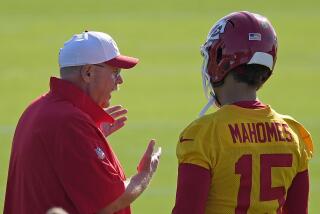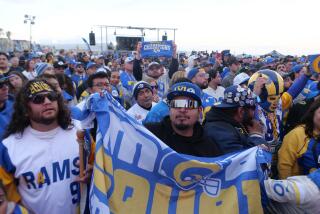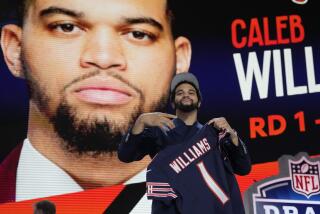NFL draft: Do’s & don’ts list
The secret to making the right moves in the NFL draft?
“It’s easy,” jokes the retired Al LoCasale, a longtime Oakland Raiders executive. “You pick the winners and avoid the losers.”
Ah, if it were so simple. Even the best talent evaluators in the business would love to bat .500 when it comes to identifying which college prospects will actually live up to their potential.
Those scouts, coaches and executives spend countless hours studying video footage, interviewing anyone and everyone associated with the player, searching for every morsel of information that might indicate whether selecting him merits what could be a multimillion-dollar investment.
“So much is put into this thing,” said Fox analyst Jimmy Johnson, former coach of the Miami Dolphins and Dallas Cowboys. “Our guys would study these players throughout their college career, you’d give them two different psychological tests. But one of the most important things to me, especially if we were taking a guy in the first round, is I just wanted to sit down and talk to him.”
Even the best minds in football can’t always spot the college players who will succeed in the pros, but there are some general guidelines most evaluators know well. Among those rules:
A bad football body doesn’t necessarily mean a bad football player: Some guys look good getting off the bus but can’t play a lick. Others have astoundingly bad bodies -- have you seen the jiggling YouTube video of Alabama tackle Andre Smith running the 40 shirtless? -- but are remarkably quick and agile on the field.
Nose tackle Kelly Gregg looked like a roly-poly farm boy when the Baltimore Ravens signed him to their practice squad in 2000. Players took to calling him Buddy Lee after the pudgy, baby-faced mascot for Lee Jeans. But Gregg could play, and still can.
“He was the most un-football-looking guy I’d ever seen,” former Ravens coach Brian Billick said. “When he showed up, I asked [then-defensive coordinator] Rex Ryan, ‘Is this your illegitimate son or what?’ But whatever you needed to get done -- stuff the run, get to the quarterback, line up at fullback -- Kelly Gregg was your guy.”
Don’t be scared off by a small school: Sure, it would be nice if all NFL prospects were as seasoned by big games as players from USC, Ohio State or Florida. That’s not to say experience under the brightest lights is a must, though.
Jerry Rice played at Mississippi Valley State. Walter Payton hailed from Jackson State. And, more recently, Ben Roethlisberger tore it up at Miami of Ohio.
When Johnson was coaching the Cowboys, he drafted All-Pro guard Larry Allen out of Sonoma State, and Pro Bowl tackle Erik Williams out of Central State in Ohio. Later with the Dolphins, Johnson drafted Jason Taylor, a future defensive player of the year, of Akron.
“It didn’t bother me what the size of the school was,” Johnson said. “Obviously, it’s easier to evaluate a player when he’s going against top talent. Sometimes you’re misled because the competition is so poor. But that doesn’t change how big, fast or strong he is, or how smart he is.”
When you take a player in the first round, make sure he can play on third down: From virtually every perspective, third down is the most important in football. You don’t want your top pick standing on the sideline in the most critical of situations.
“If he doesn’t play on third down, he’s only going to play in 42% of the [offensive or defensive] plays,” said former personnel executive Mike Lombardi, now an analyst for the NFL Network.
“So he’d better be really good on first and second” to justify taking him that high. Lombardi said linebacker Bobby Carpenter, taken 16th by Dallas in 2006, is an example of a player who isn’t good enough on third down to warrant such a high pick.
When you make a selection, be sure you actually have the pick: A lot of crazy things can happen when a team is on the clock, preparing to draft a player. Five years ago, the Ravens were planning to draft linebacker Roderick Green in the fourth round. Billick called to give him the good news and congratulate him on joining the team. The coach then handed the phone to owner Steve Bisciotti.
“Wait!” General Manager Ozzie Newsome said. “Hang up the phone! We just traded the pick!”
After some awkward apologies, the Ravens and Green parted ways . . . for an hour or so. Baltimore took him in the next round.
When you make a selection, be sure the player actually has a pulse: Lots of peculiar things have happened in the NFL draft, but it’s hard to imagine anything that matches what happened to some of our football neighbors to the north.
Twice in the Canadian Football League -- first with the Ottawa Rough Riders in 1995 and Montreal Alouettes in 1996 -- teams selected players who had died months earlier.
That, Johnson said, is one of the reasons it’s so important to get a player on the phone to make sure everything is OK just before a selection is made.
“Once or twice, I couldn’t get ahold of him,” the coach said. “Normally, they’d be right by their phone. ‘Any car wrecks in the last 30 minutes?’ ”
It’s never too early to start negotiations: Coming off an 0-16 season, the Detroit Lions cannot afford to have their No. 1 pick miss any time because of a contract holdout. That’s why it’s entirely possible, likely even, that a deal will be in place before the pick is announced.
That was the case three years ago, when the Houston Texans offered contracts to Mario Williams and Reggie Bush, and went with the player (Williams) who agreed to terms. That signing was announced the night before the draft.
When Johnson was with the Cowboys, he liked to work out the rough parameters of a deal over the phone with the prospective pick just to make sure it wouldn’t be a problem signing the player.
“I’d say, ‘It’s between you and another player. Here’s the contract. Get your agent on the phone and let’s agree to this,’ ” Johnson said. “I’d tell them that we could work out the incentives and the options later, but here was the base contract and the number of years.”
Stick with your convictions, but try to sort through the rumors and gossip to find the reports that have merit: The mere hint of a failed drug test can cost a prospect millions of dollars, especially in a league that’s increasingly sensitive about the off-the-field misdeeds of its players.
Sometimes, those reports are legitimate. Other times -- including in some cases this year -- they’re simply wrong, and could have been floated for all sorts of reasons. The best evaluators are good about finding the truth through the fog of deception.
“It’s liar’s poker out there,” Billick said. “Every place I’ve ever been, there’s always the admonition: ‘Don’t tell anybody anything, but go out and get as much information as you can from your buddies.’ Oh, sure, you’re going to really get information that way. That’s how rumors spread.
“It’s not if you lie. It’s just a matter of degree with which you lie.”
--
Follow Sam Farmer’s NFL draft coverage on Twitter at twitter.com/latimesfarmer.
More to Read
Go beyond the scoreboard
Get the latest on L.A.'s teams in the daily Sports Report newsletter.
You may occasionally receive promotional content from the Los Angeles Times.











